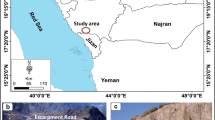Abstract
Ensuring stability of rock slopes is an essential requirement in the progress of our societies today. Rock determined to be loose or with potential for failure must be removed or restrained in some way. In our work, after doing an inventory of the instabilities that occurred in the last 5 years in the Basque Country, we analyse the different factors, in slope stability. The potential for failure is evaluated for different classes of rock mass, characterized previously by their geomechanical properties. The characterization of potential risk of each one is undertaken by considering 10 parameters that define the nature of mass rock, relative orientation and morphological features of the slope (interaction rock massif-slope) and infrastructure features (interaction rock massif-slope-infrastructure). Each of these parameters is evaluated separately and a Risk Factor (RF) is determined. The RF reaches a maximum value of 10,000 and allows to differentiate four categories of slopes; each category has its own priority. Rock mass characteristics also determine the potential damage from instability and the associated correction measures. The systematic evaluation of instabilities must allow establishing a priority in the correction measures and thus optimise the available economic resources.







Similar content being viewed by others
References
Badger TC, Lowell S (1992) Rockfall control Washington State. In: Rockfall Prediction and Control and Landslide Case Histories, Transp. Research Record, National Research Council, Washington, 1342:14–19
Bell DH, Pettinga JR (1988) Bedding-controlled landslides in New Zealand soft rock terrain. In: Proceedings of the fifth international symposium on landslides, Lausanne, pp 77–83
Bieniawski ZT (1989) Engineering rock mass classifications. Wiley, NY, p 251
Boillot G, Capdevilla R (1977) The Pyrenees: subduction and collision? Earth Planet Sci Lett 35:151–160
Brawner CO, Wyllie DC (1975) Rock slope stability on railway projects. In: Proceedings of the American Railway Engineering Association Regional Meeting, Vancouver, BC; American Railway Engineering Association, Washington, DC
Deere DU (1964) Technical description of rock cores for engineering purposes. Rock Mech Eng Geol 1(1):16–22
Feuille P, Rat P (1971) Structures et páleogéographie pyréneo-cantabrique. Hist St du golfe de Gascogne Edn Technip 2:V-1-1–V-1-48
Franklin JA, Senior SA (1997) Outline of RHRON, the Ontario rockfall hazard rating system. In: Proceedings of the international symposium on engineering geology and environment, Athens, Greece, pp 647–656
García Mondejar J, Hines FM, Pujalte V, Reading HG (1985) Sedimentation and tectonics in the western Basque–Cantabrian area (northern Spain) during Cretaceous and Tertiary times. In: Mila MD, Rosell J (eds) Sixth European Regional Meeting. Excursion guidebook, pp 307–392
Goodman RE (1989) Introduction to rock mechanics. Wiley, NY
Haramy KY, De Marco MJ (1985) Use of the Schmidt hammer for rock and coal testing. In: Proceedings of the 26th U.S., symposium on Rock Mech. Rapid City, pp 549–555
Hoek E (1998) Reliability of Hoek–Brown estimates of rock mass properties and their impact on design. Int J Rock Mech Min Sci 35(1):63–68
Hoek E (2000) Practical rock engineering. Course notes. Evert Hoek Consulting Engineer Inc., Canada
Hungr O, Evans SG (1989) Engineering aspects of rockfall hazard in Canada. In: Geological Survey of Canada, Open File 2061
ISRM (international Society for Rock Mechanics) (1979) Suggested methods for determination of the slake durability index. Int J Rock Mech Min Sci Geomech Abstr 16:154–156
Kolaiti E, Papadopoulus Z (1993) Evaluation of Schmidt rebound hammer testing: a critical approach. Bull Int Assoc Eng Geol (IAEG) 48:69–76
Marinos P, Hoek E (2001) Estimating the geotechnical properties of heterogeneous rock masses such a flysch. Bull Eng Geol Env 60(2):85–92
Martinez-Torres LM (1989) El manto de los mármoles (Pirineo Occidental): Geología estructural y evolución geodinámica. PhD Thesis, University of The Basque Country
Miller M (2003) Development and implementation of the Idaho Highway Slope Instability and Management System (HISIMS). National Institute for Advanced Transportation Technology (NIATT), University of Idaho
Moon V, Russell G, Stewart M (2001) The value of rock mass classification systems for weak rock masses: a case example from Huntly, New Zealand. Eng Geol 61:53–67
Morales T, Uribe-Etxebarria G, Uriarte JA, Fernandez de Valderrama I (2004) Geomechanical characterisation of rock masses in Alpine regions: the Basque Arc (Basque–Cantabrian basin, Northern Spain). Eng Geol 71:343–362
Morgenstern NR (1997) Toward landslide risk assessment in practice. In: Cruden DY, Fell R (eds) Landslide risk assessment. A. A. Balkema, Rotterdam, Brookfield, pp 15–24
Pierson LA, Van Vickle (1993) Rockfall hazard rating system-participants manual. In: Federal Highway Administration Report FH-WA-SA-93-057, FHWA, Washington, DC
Pierson LA, Davis SA, Van Vickle R (1990) Rockfall hazard rating system implement manual. In: Federal Highway Administration (FHWA) Report FHWA-OREG-90-01. FHWA, U.S. Department of Transportation
Ramirez Del Pozo J (1973) Síntesis geológica de la provincia de Álava. Obra Cultural de la Caja de Ahorros de la Ciudad de Vitoria
Read SA, Millar PJ (1990) Characterisation and classification of New Zealand Tertiary age sedimentary soft rocks. Road Research Unit, Transit New Zealand, Bull 84:1–25
Romana M (1992) Métodos de corrección de taludes según la clasificación geomecánica SMR. In: III Simposio Nacional sobre Taludes y Laderas Inestables, La Coruña, pp 629–650
Wyllie D (1987) Rock slope inventory/maintenance programs. In: FHWA Rockfall Mitigation Seminar, 13th Northwest Geotechnical Workshop, Portland, Oregon
Acknowledgements
This work was supported by The University of the Basque Country. Project 1/UPV 00001.310-E-13915/2001: Caracterización de la inestabilidad de taludes en macizos interestratificados del País Vasco: aspectos geomecánicos, interacción precipitación-inestabilidad y análisis de riesgos.
Author information
Authors and Affiliations
Corresponding author
Rights and permissions
About this article
Cite this article
Uribe-Etxebarria, G., Morales, T., Uriarte, J.A. et al. Rock cut stability assessment in mountainous regions. Environ Geol 48, 1002–1013 (2005). https://doi.org/10.1007/s00254-005-1323-1
Received:
Accepted:
Published:
Issue Date:
DOI: https://doi.org/10.1007/s00254-005-1323-1




